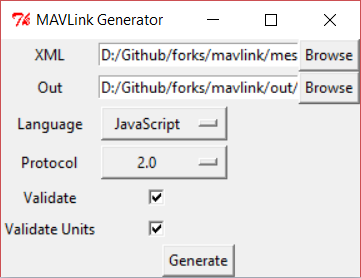Generating MAVLink Libraries
Language-specific MAVLink libraries can be created from XML Message Definitions using code generator tools.
This topic shows how to use the two code generators provided with the MAVLink project: mavgenerate (GUI) and mavgen (command line).
These generators can build MAVLink 2 libraries for C, C++11, Python, Typescript, Java, and WLua (supporting both MAVLink 2 and 1), and MAVLink 1 (only) libraries for: C#, JavaScript, ObjC, Swift.
Generators for other programming languages are supported and documented in independent progects. For more information see Supported Languages.
Pre-requisites
- You must already have Installed MAVLink (including both the tools below and XML Message Definitions).
- If you are generating messages for a custom dialect, copy the file(s) into the directory message_definitions/v1.0/.
mavgen can handle dialects that have relative paths for included XML files (e.g typically common.xml), but other generators may not. We recommend putting custom dialects in the same folder as the ones that come with the mavlink/mavlink repository.
Mavenerate (GUI)
mavgenerate.py is GUI code generator for MAVLink, written in Python.
Mavgenerate provides a GUI front end to the mavgen command line code generator, and supports the same options.
The GUI can be launched from anywhere using Python's -m argument:
python -m mavgenerate

Generator Steps:
Choose the target XML file (typically in mavlink/message_definitions/1.0).
If using a custom dialect, first copy it into the above directory (if the dialect is dependent on common.xml it must be located in the same directory).
- Choose an output directory (e.g. mavlink/include).
- Select the target output programming language.
- Select the target MAVLink protocol version (ideally 2.0)
Generation will fail if the protocol is not supported by the selected programming language.
- Optionally check Validate and/or Validate Units (if checked validates XML specifications).
- Click Generate to create the source files.
Mavgen (Command Line)
mavgen.py is a command-line tool for generating MAVLink libraries for different programming languages. After the mavlink directory has been added to the PYTHONPATH, it can be run by executing from the command line.
This is the backend used by mavgenerate. The documentation below explains all the options for both tools.
For example, to generate MAVLink 2 C libraries for a dialect named your_custom_dialect.xml.
python -m pymavlink.tools.mavgen --lang=C --wire-protocol=2.0 --output=generated/include/mavlink/v2.0 message_definitions/v1.0/your_custom_dialect.xml
The syntax for for generating Python modules is the same, except that the
--outputspecifies a filename rather than a directory.
The full syntax and options can be output by running mavgen with the -h flag (reproduced below):
usage: mavgen.py [-h] [-o OUTPUT]
[--lang {C,CS,JavaScript,TypeScript,Python,WLua,ObjC,Swift,Java,C++11}]
[--wire-protocol {0.9,1.0,2.0}] [--no-validate]
[--error-limit ERROR_LIMIT] [--strict-units]
XML [XML ...]
This tool generate implementations from MAVLink message definitions
positional arguments:
XML MAVLink definitions
optional arguments:
-h, --help show this help message and exit
-o OUTPUT, --output OUTPUT
output directory.
--lang {C,CS,JavaScript,TypeScript,Python,WLua,ObjC,Swift,Java,C++11}
language of generated code [default: Python]
--wire-protocol {0.9,1.0,2.0}
MAVLink protocol version. [default: 1.0]
--no-validate Do not perform XML validation. Can speed up code
generation if XML files are known to be correct.
--error-limit ERROR_LIMIT
maximum number of validation errors to display
--strict-units Perform validation of units attributes.
